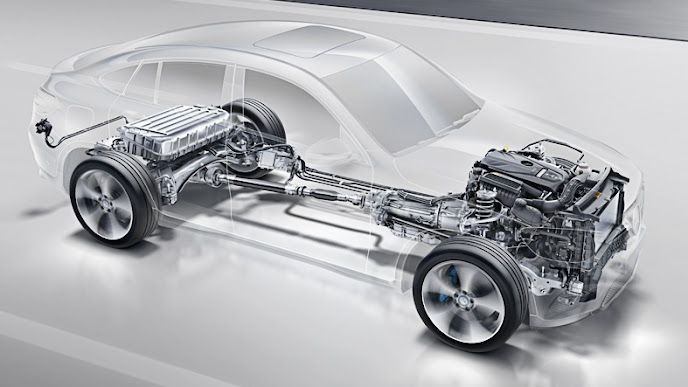All Wheel Drive: How It Works and Its Benefits for Drivers
 |
| All Wheel Drive |
What is All Wheel Drive?
All wheel drive, also known as AWD, refers to a vehicle propulsion system that
has power delivered to all road wheels in the vehicle, either simultaneously or
individually, in a way that provides improved traction to the wheels when
compared to two-wheel drive vehicles. The system allows power from the engine
to be routed to all road wheels through either a transfer case or a more
sophisticated control unit that monitors driving conditions and automatically
adjusts power delivery.
Mechanical Components of an AWD System
All wheel drive systems use a combination of mechanical and electronic components
to deliver power to all four wheels. At the core is a transfer case or central
differential that connects the engine's power take-off unit to both the front
and rear axles. This allows power to be split between the front and rear
wheels. It also features a center differential that allows the wheels with more
traction to receive more torque. Additional components include front and rear
differentials that ensure wheels on each axle turn at different speeds during
cornering. Some modern AWD variants have electronically controlled locking
differentials to further enhance traction.
When Traction is Lost the AWD Kicks In
In most normal driving conditions when good traction is available, an All
Wheel Drive vehicle functions like a front or rear-wheel drive car with
power being primarily sent to the front or rear axles. However, as soon as one
of the driven wheels loses traction, the AWD system automatically transfers
power to the axle with the better traction by means of the transfer case and
differentials. This allows power delivery to be balanced out across all four
wheels to maximize available traction. Compared to two-wheel drive vehicles,
AWD provides consistently better acceleration, handling, and control on low
traction surfaces.
AWD Driving Modes for Different Terrains
More sophisticated AWD systems feature different driving modes tailored for
varying road conditions. For example, some vehicles have a two-wheel drive mode
for better fuel efficiency on dry surfaces and an all-wheel drive mode engaged
via a dashboard button for inclement weather. Others include settings like
snow, mud or sand that optimize power delivery for better traction on slippery
surfaces. Some high-end AWD cars have modes like sport that allow for a more
rear-biased power split for improved performance and handling characteristics
on dry pavement. These settings help drivers get the most out of the all-wheel
drive system across different terrains and weather.
Traction Benefits in Adverse Conditions
The most evident benefit of all-wheel drive traction comes into play when
driving on low traction surfaces like wet or slippery roads, gravel, snow and
ice. With power going to all four wheels, AWD vehicles are much less prone to
losing traction and spinning wheels compared to two-wheel drive cars. This
makes them inherently safer and more sure-footed on slippery surfaces. The
balanced power delivery also ensures better acceleration from a stop without
excessive wheelspin, even under poor traction conditions. As a result, AWD is
widely recommended or mandated for drivers living in regions with heavy wintry
conditions.
Improved Stability and Handling
While the traction advantages dominate under low grip scenarios, all-wheel
drive also subtly improves handling dynamics even under normal dry road
conditions. By having drive delivered to all four wheels, an AWD vehicle has
greater front-rear as well as side-to-side weight transfer under heavy cornering,
braking or acceleration forces. This allows the sophisticated
computer-controlled differentials to help rotate the car into corners more
predictably for razor-sharp turn-in response and balance through bends. It can
also enhance steering feel and feedback. Overall, the neutral cornering
behavior means better on-road stability at both high and low speeds compared to
rear or front-wheel drive cars.
AWD Usage in Performance Cars
While traction was initially the primary motivation, all-wheel drive is now a
standard fixture even in performance-oriented sports cars and luxury vehicles.
By providing balanced power delivery and optimal grip from all four wheels, AWD
improves acceleration off the line and allows cars to put down maximum power
smoothly coming out of turns. This translates to deceptively quick straight
line speed. Additionally, the neutral cornering balance means AWD sports cars
can carry higher cornering speeds through bends without understeer or
oversteer. As a result, today even high-end exotic brands like Lamborghini,
Ferrari and Porsche offer all-wheel drive variants that take advantage of the
technology for scintillating acceleration both on and off the track.
Maintenance Requirements
The complex transfer case and additional differentials do make all-wheel drive
vehicles marginally more expensive to maintain compared to two-wheel drive
cars. Owners need to change AWD-specific fluids and components like the front
and rear differentials, transfer case and associated bearings at the intervals
recommended in the owner's manual. It's also advisable to have the all-wheel
drive coupling inspected if unusually harsh vibration or noises emerge from the
drivetrain. However, with scheduled servicing the maintenance costs are quite
reasonable considering the substantial traction and handling benefits all-wheel
drive provides year-round and in varied terrain and weather conditions.
Get
more insights on All
Wheel Drive


%20Treatment%20(1).jpg)
Comments
Post a Comment